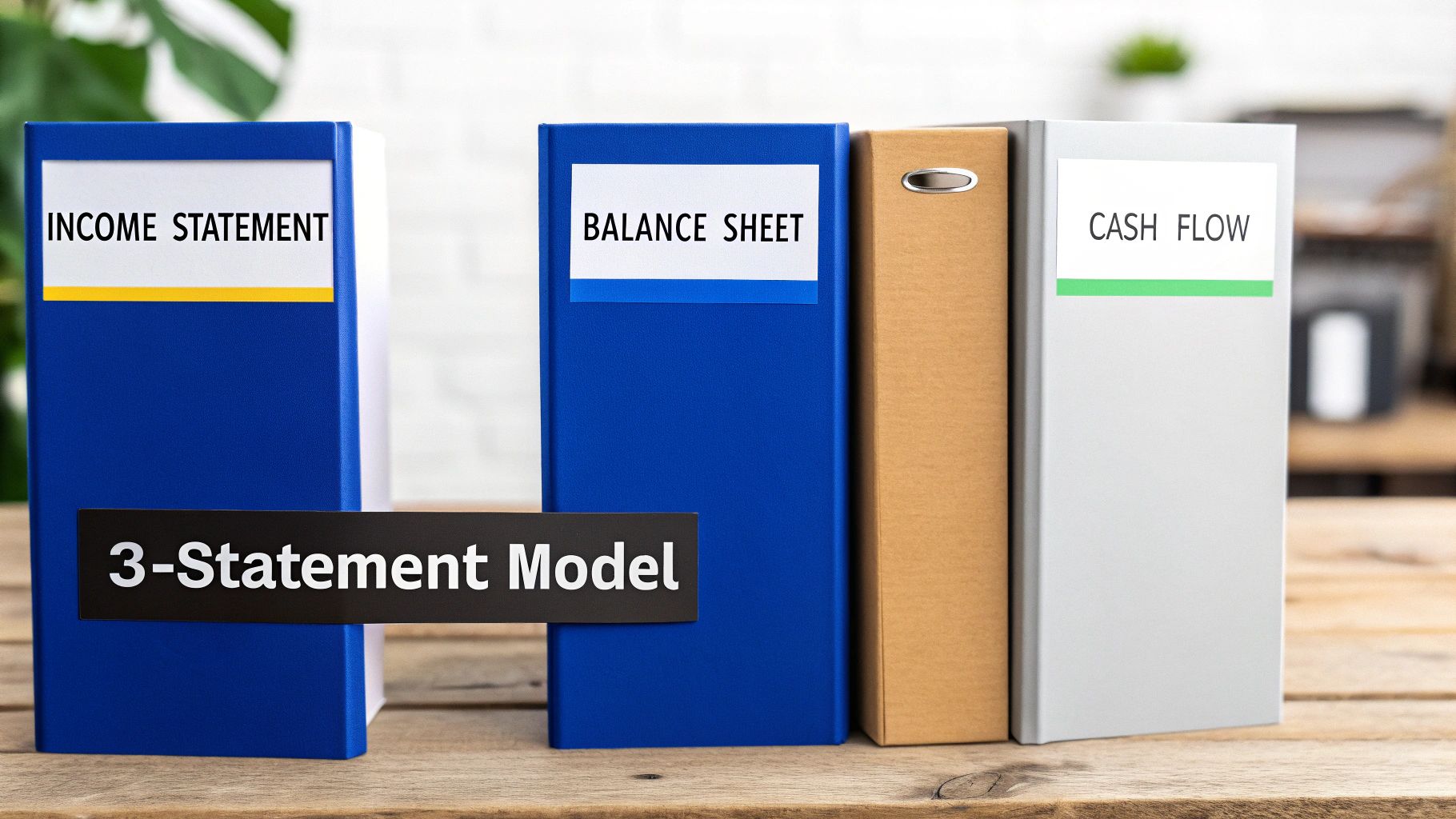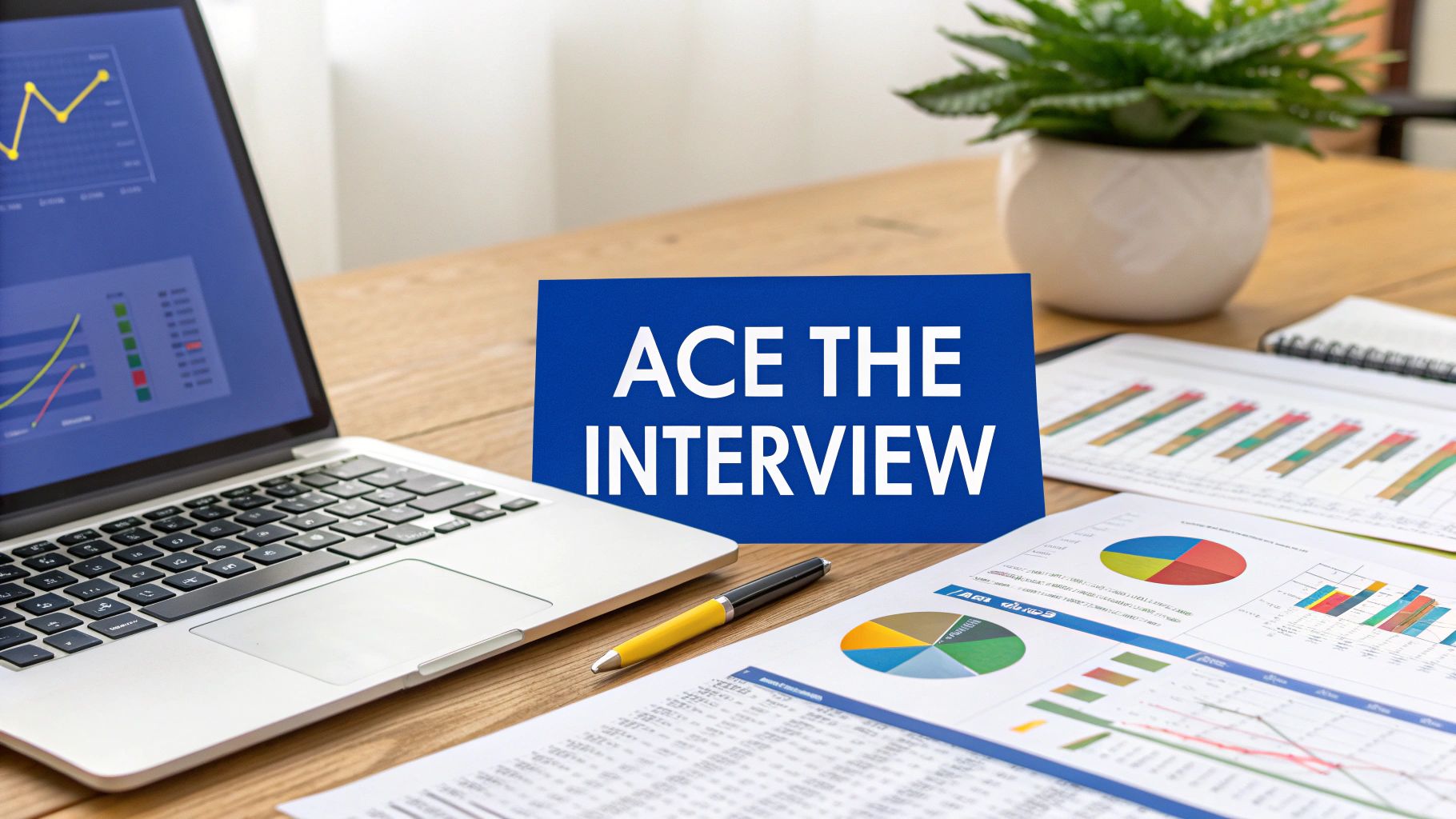Stepping into a financial analyst interview can feel like a high-stakes examination of your technical skills, business acumen, and composure under pressure. Hiring managers are searching for more than just correct answers to standard financial analyst interview questions; they want to witness your analytical process, assess your communication style, and gauge your potential to deliver tangible business impact. From complex modelling case studies to nuanced behavioural scenarios, each question is designed to test a specific competency critical for success in the role.
This comprehensive guide is organised to deconstruct the most common and challenging questions you will likely face. We move beyond generic advice to provide structured frameworks for your answers, expert tips on what interviewers are truly looking for, and common pitfalls to avoid. Our goal is to equip you with the strategic tools needed to articulate your value clearly and confidently. By mastering the approaches detailed here, you will be prepared to demonstrate not just your knowledge, but your ability to think like a seasoned analyst. This preparation will help you navigate the interview process effectively and secure your next position. Let's explore the questions that separate promising candidates from exceptional hires.
1. Walk Me Through a Financial Model You've Built
This question is a cornerstone of financial analyst interview questions because it moves beyond theory and directly assesses your practical skills. Interviewers use it to evaluate your technical modelling ability, your logical thought process, and crucially, your communication skills. They want to see if you can explain a complex project clearly and concisely.

When answering, you need to articulate the model's purpose, structure, key assumptions, and final outputs. This demonstrates not just that you can build something, but that you understand the business context behind it.
How to Structure Your Answer
A strong response follows a clear, logical narrative. Start with the "why" before diving into the "how."
- Business Context: Briefly explain the project's objective. Was it for M&A due diligence, a valuation for equity research, or an internal budget analysis?
- Model Structure: Describe the model’s layout. For instance, you might say, "I built a three-statement model that linked the income statement, balance sheet, and cash flow statement. Key inputs were on a separate tab for clarity."
- Key Drivers & Assumptions: Highlight the most sensitive inputs. Discuss how you arrived at your assumptions for revenue growth, margins, or capital expenditures. Did you use historical data, industry research, or management guidance?
- Outputs & Conclusion: Explain what the model produced, such as a valuation range or a sensitivity analysis, and what business decision it supported.
Pro Tip: Prepare two or three different models you can discuss in detail. Tailor your choice to the role; for an M&A role, focus on a merger model, while for a corporate finance role, a budgeting model might be more relevant. Beyond just building a model, interviewers are keen to see if you understand the industry's best standards; explore these additional resources on effective financial modeling best practices to refine your approach.
2. Describe a Time You Found an Error in Financial Data - Behavioral/Situational
This is one of the classic behavioral financial analyst interview questions designed to test your attention to detail, integrity, and problem-solving skills under pressure. Interviewers want to gauge how you react when faced with a mistake, whether you take ownership, and how you communicate the issue to your team. It's a direct window into your work ethic and critical thinking capabilities.
Your response should demonstrate a proactive, rather than reactive, approach to data integrity. They are looking for candidates who not only fix a problem but also think about how to prevent it from happening again.
How to Structure Your Answer
The STAR method (Situation, Task, Action, Result) is the perfect framework for a compelling and structured response.
- Situation: Briefly describe the context. For instance, "During the quarterly close, I was reconciling revenue accounts for the European division."
- Task: Explain your specific responsibility. "My task was to validate the data from our new sales CRM against the figures booked in our accounting system."
- Action: Detail the specific steps you took. "I noticed a £500,000 variance and traced it back to a data entry error where a batch of invoices was duplicated. I immediately documented the discrepancy, corrected the entry, and informed my manager with a clear explanation of the cause and impact."
- Result: Quantify the outcome and highlight the lesson. "This prevented our quarterly revenue from being overstated by £500,000. Following this, I collaborated with the IT team to implement a validation rule in the system to flag potential duplicate entries, improving our data accuracy going forward."
Pro Tip: Choose a real, specific example. Vague answers suggest you either haven't encountered such a situation or lack attention to detail. Focus on the process of discovery and resolution, not just the error itself. Emphasise how your actions improved a process, demonstrating your value beyond simply completing tasks. Honing your storytelling for remote interviews is crucial; review these virtual interview tips to ensure your examples land effectively.
3. How Would You Value This Company? - Case Study & Valuation
This is a classic case study question designed to test your entire analytical toolkit in real time. Interviewers present a hypothetical company and ask for your valuation approach to gauge your structured thinking, financial acumen, and ability to perform under pressure. They want to see how you synthesise limited information and ask intelligent questions.
Your ability to outline a logical framework and discuss various valuation methodologies is more important than arriving at a single "correct" number. This question reveals your understanding of how different valuation techniques apply to different business models and industries, a key skill for any financial analyst.
How to Structure Your Answer
A strong answer begins with clarifying questions and a clear roadmap. Don't jump straight into calculations; outline your approach first.
- Ask Clarifying Questions: Start by gathering more information. What industry is it in? Is it public or private? What are its historical financials and growth prospects? Who are its main competitors?
- Outline Your Framework: State the primary valuation methods you would use. A comprehensive answer will always mention Discounted Cash Flow (DCF), Comparable Company Analysis (Comps), and Precedent Transactions.
- Discuss Each Method: Briefly explain how you would apply each technique. For a DCF, mention forecasting free cash flows, determining a discount rate (WACC), and calculating a terminal value. For comps, discuss selecting a peer group and relevant multiples like EV/EBITDA.
- Synthesise and Conclude: Explain how you would triangulate the results from each method to arrive at a valuation range. Acknowledge the limitations of your analysis and the key assumptions that drive the final valuation.
Pro Tip: Always state your assumptions clearly and justify them. For example, when discussing the discount rate, explain how you would determine the cost of equity (using CAPM) and cost of debt. This demonstrates a deeper level of understanding that impresses interviewers.
4. Walk Me Through a 3-Statement Model - Technical & Excel Skills
This is a fundamental technical question in many financial analyst interviews, designed to rigorously test your understanding of accounting and Excel mechanics. Interviewers want to confirm you can build a dynamic, integrated financial model from scratch, proving you grasp how the income statement, balance sheet, and cash flow statement interact. It’s a direct assessment of your core technical competence.

Successfully answering requires more than just listing steps; it means explaining the logic behind each link. You must show how revenue flows to net income, how net income becomes the starting point for cash flow, and how changes in cash, assets, and liabilities are reflected to ensure the balance sheet always balances.
How to Structure Your Answer
A clear, step-by-step walkthrough is essential. Start at the top of the income statement and logically progress through all three statements, explaining each connection.
- Start with the Income Statement: Begin with revenue and work down to Net Income. Explain your assumptions for key drivers like revenue growth and operating margins.
- Link to the Cash Flow Statement: State that Net Income is the starting point for the Cash Flow from Operations section. Systematically add back non-cash charges like depreciation and adjust for changes in working capital (accounts receivable, inventory, accounts payable).
- Complete the Cash Flow Statement: Detail the Cash Flow from Investing (primarily capital expenditures) and Cash Flow from Financing (debt issuance, share buybacks) sections. Calculate the net change in cash.
- Link to the Balance Sheet: Connect the ending cash balance from the cash flow statement to the cash account on the balance sheet. Link other items like Net Income to Retained Earnings, capital expenditures to Property, Plant & Equipment (PP&E), and debt changes to the relevant liability accounts. Finally, confirm the balance sheet balances (Total Assets = Total Liabilities + Shareholders' Equity).
Pro Tip: Practice building a simple 3-statement model until you can do it quickly and confidently. Be prepared to discuss why Net Income is not the same as cash flow, citing depreciation and working capital changes. Mastering this process is a non-negotiable part of the financial analyst skills required for top-tier roles.
5. Tell Me About a Complex Problem You Solved - Communication & Problem-Solving
This behavioural question is designed to assess your analytical rigor, problem-solving skills, and business judgement. Unlike technical questions, this one reveals how you think under pressure and approach ambiguous situations. Interviewers are keen to understand your methodology for breaking down complexity and how effectively you communicate your findings to influence business decisions.
Your answer should tell a story that highlights your ability to turn raw data into a compelling business case. It’s an opportunity to demonstrate not just your analytical skills, but also your impact on the organisation. This is a common query in financial analyst interview questions because it connects your past performance directly to the challenges you might face in the new role.
How to Structure Your Answer
The STAR (Situation, Task, Action, Result) method is the perfect framework for this question. It ensures your story is structured, concise, and impactful.
- Situation: Briefly set the scene. What was the business problem? For example, "The company was experiencing a consistent decline in gross margins, but the leadership team was unsure of the root cause."
- Task: What was your specific responsibility? "My task was to analyse profitability by product line and customer segment to identify the key drivers behind the margin compression."
- Action: Describe the steps you took. "I consolidated sales data from our CRM with cost data from the ERP system, built a profitability model, and performed a variance analysis. I collaborated with the sales team to understand pricing strategies and with operations to validate cost allocations."
- Result: Quantify the impact of your work. "My analysis revealed that two legacy product lines were significantly unprofitable. I presented my findings to senior management, which led to a strategic decision to restructure pricing on those products, improving overall gross margin by 2% within six months."
Pro Tip: Prepare a story where you not only solved the problem but also influenced decision-makers. Explain how you tailored your communication for different stakeholders, such as presenting a detailed model to the finance director but a high-level summary with key recommendations to the CEO. This demonstrates strategic awareness.
6. How Do You Calculate WACC and Why Does It Matter?
This question is a fundamental test of your core valuation knowledge. Interviewers ask about the Weighted Average Cost of Capital (WACC) to gauge your understanding of corporate finance theory and its practical application in valuing a business. It's a critical component in Discounted Cash Flow (DCF) analysis, and your ability to explain it demonstrates technical proficiency.
A strong answer shows you can break down a complex formula into its core components and explain the business logic behind each one. They want to see that you understand how a company’s capital structure and risk profile directly influence its cost of capital and, ultimately, its valuation.
How to Structure Your Answer
Begin with a clear definition before deconstructing the formula and explaining its significance in business decisions.
- Define WACC: Start by defining WACC as the blended cost of a company's capital from all sources, primarily debt and equity, weighted by their respective proportions in the capital structure.
- Explain the Formula: Walk through the formula: WACC = (E/V × Re) + (D/V × Rd × (1-Tc)). Clearly define each variable: Cost of Equity (Re), Cost of Debt (Rd), the market values of equity (E) and debt (D), the total value of capital (V), and the corporate tax rate (Tc).
- Break Down Components: Discuss how you would calculate the Cost of Equity, typically using the Capital Asset Pricing Model (CAPM). Explain why the Cost of Debt is adjusted for taxes, referencing the tax shield benefit of interest payments.
- Practical Application: Conclude by explaining WACC's primary role as the discount rate in a DCF model to find a company's present value. Mention how a higher WACC implies greater risk and results in a lower valuation.
Pro Tip: Be prepared to discuss how different factors impact WACC. For instance, explain how a company in a stable, low-risk industry (like a utility) would have a lower WACC than a high-growth, volatile tech start-up. Also, be ready to discuss how increasing leverage initially lowers WACC but can increase it beyond an optimal point due to heightened financial risk.
7. Analyze This Company's Financial Statements - Accounting & Financial Analysis
This case-study style question is a direct test of your core technical skills. Interviewers will provide a company's financial statements (income statement, balance sheet, and cash flow statement) and ask for your analysis. They are evaluating your ability to interpret data, calculate key metrics, identify trends, and synthesise your findings into a coherent assessment of the company's financial health and performance.

This exercise demonstrates whether you can move beyond just reading numbers to truly understanding the story they tell. It's a fundamental part of the financial analyst role, and your performance here highlights your practical accounting knowledge and analytical reasoning.
How to Structure Your Answer
A methodical approach is crucial. Begin with a high-level overview and then drill down into the specifics, connecting insights across the three statements.
- Start with the Income Statement: Analyse revenue growth, gross and operating margins over time. Look for one-off items that might distort profitability and discuss the quality of earnings. Is the growth organic and sustainable?
- Move to the Balance Sheet: Examine the company's capital structure. How has its debt level changed? Look at working capital components like accounts receivable and inventory. An inventory buildup, for example, could be a red flag for a retail company.
- Analyse the Cash Flow Statement: This is often the most revealing statement. Compare net income to cash from operations. A company showing strong profits but weak operating cash flow might have issues with its business model or revenue recognition policies.
- Synthesise and Conclude: Bring your points together to form a conclusion. Summarise 2-3 key takeaways about the company's financial health, performance, and potential risks or opportunities.
Pro Tip: Structure your analysis like you are presenting to a senior manager. Start with the "so what?" - the key conclusions - before walking through the supporting details. This shows you can communicate effectively and prioritise information. Mastering this skill is a core component of the financial analyst job requirements for any top-tier position.
8. Walk Me Through a Recent M&A Transaction
This question probes your ability to apply financial concepts to a real-world scenario, combining technical knowledge with market awareness and strategic thinking. Interviewers want to see if you follow the market, understand deal rationale, and can critically analyse a major corporate decision. It’s a test of your business acumen as much as your financial skills.
Discussing a deal like Microsoft's acquisition of Activision Blizzard or Adobe's acquisition of Figma allows you to demonstrate your grasp of valuation, synergies, and deal structure. Your ability to articulate the strategic fit and financial implications reveals a deeper, more practical understanding of corporate finance.
How to Structure Your Answer
A well-structured answer tells a compelling story about the transaction. Choose a recent deal that you find genuinely interesting and have researched thoroughly.
- Deal Overview: Start with the basics. Who acquired whom, and for how much? Mention key details like the purchase price and the implied valuation multiples (e.g., EV/EBITDA).
- Strategic Rationale: Explain why the deal happened. Was the acquirer entering a new market, eliminating a competitor, or acquiring key technology?
- Synergies & Financial Impact: Discuss the expected cost and revenue synergies. Explain whether the deal was expected to be accretive or dilutive to the acquirer's earnings per share (EPS) and why.
- Risks & Your Opinion: Conclude with a critical analysis. What were the integration risks or regulatory hurdles? Do you think it was a good deal? Offer a thoughtful perspective supported by your analysis.
Pro Tip: Prepare two different transactions you can discuss. Research the deal's announcement, the strategic logic presented by management, and any subsequent performance data. Being able to intelligently critique the transaction, mentioning what you might have done differently or what you see as the biggest challenge, will set you apart.
9. You Have 30 Minutes to Build a Model - Excel Skills & Speed
This is a high-pressure, practical test designed to evaluate your technical proficiency, speed, and accuracy in a real-world scenario. Interviewers use this exercise to see if you can think on your feet, prioritise essential tasks, and deliver a functional model under a tight deadline. It’s a direct assessment of your hands-on Excel and financial modelling skills, moving far beyond theoretical knowledge.
This task separates candidates who can talk about finance from those who can actually do the work. Your ability to stay organised, use shortcuts, and produce a clean, logical model is as important as the final numbers. It’s a common feature in investment banking and private equity interviews where speed is critical.
How to Structure Your Approach
Success in a timed test relies on efficiency and a clear plan. Focus on building a solid foundation first and adding complexity if time permits.
- Understand the Goal: Quickly clarify the objective. Is it a three-statement projection, a Discounted Cash Flow (DCF) valuation, or a quick comparable companies analysis?
- Set Up Your Structure: Start by laying out the core sections. Create a dedicated assumptions tab and then structure the primary statements or analyses. Good organisation from the start saves time later.
- Prioritise Key Drivers: Begin with the most important inputs, like revenue growth and key expense margins. Build the core logic and link the statements together before moving on to less critical details.
- Execute and Review: Use keyboard shortcuts extensively to speed up your workflow. As you build, double-check your formulae. If time allows, perform a quick review to catch any obvious errors.
Pro Tip: Don't aim for perfection; aim for a functional, well-structured model. It's better to deliver a simple, accurate model than a complex, broken one. Before the interview, practise building small models from scratch within a 30-minute window to simulate the pressure and refine your process.
10. How Would You Approach Forecasting Revenue for This Company?
This question directly probes your business acumen and analytical rigor. Interviewers use it to see if you can think like a business owner, not just a spreadsheet operator. Your answer reveals your understanding of what drives a business, your knowledge of the industry, and your ability to build a logical, defensible forecast from scratch.
A strong answer combines a structured methodology with specific knowledge of the company’s business model. It’s not about finding one "right" number; it’s about demonstrating a thoughtful process for arriving at a reasonable range of outcomes.
How to Structure Your Answer
Begin by asking clarifying questions before presenting a structured forecasting approach. Show the interviewer you need context before diving into numbers.
- Clarify & Contextualise: First, ask about the company’s business model, competitive position, and growth stage. This shows you tailor your analysis instead of using a generic formula.
- Choose an Approach: State your primary forecasting method. For a SaaS company, you might use a bottom-up build based on customer count, average contract value (ACV), and churn. For a retailer, you might use a top-down approach starting with market size and market share assumptions.
- Identify Key Drivers: Detail the specific metrics you would use. For an e-commerce business, this could be customer acquisition rates and average order value. For manufacturing, it would be production capacity, utilisation, and pricing.
- Discuss Risks & Scenarios: Acknowledge the forecast's limitations. Explain that you would build multiple scenarios (base, upside, downside) and perform a sensitivity analysis on key assumptions like pricing or market growth.
Pro Tip: Always blend a top-down and bottom-up approach as a cross-check. Start with a top-down analysis using the Total Addressable Market (TAM) to frame the opportunity, then build a more granular bottom-up forecast. If the two produce wildly different results, it’s a great discussion point about your assumptions.
10 Financial Analyst Interview Questions Comparison
Beyond the Answers: Your Path to Interview Success
Mastering the top financial analyst interview questions requires more than just memorising definitions and formulas. As we've explored, the most compelling candidates demonstrate a holistic skill set that blends technical prowess with strategic thinking and clear communication. Your goal isn't just to provide the correct answer but to showcase how you arrive at it, revealing a structured, analytical mind at work.
From walking an interviewer through a 3-statement model to deconstructing a recent M&A deal, each question is a platform. It's your opportunity to prove you can not only perform complex calculations like WACC but also understand their real-world implications for business valuation and strategy.
Your Actionable Roadmap to Acing the Interview
To transform this knowledge into a successful interview performance, focus on these critical next steps:
- Build Your Story Bank: For behavioural questions like "describe a time you found an error," don't just have one example. Develop a small portfolio of stories using the STAR (Situation, Task, Action, Result) method. Quantify your results whenever possible to demonstrate tangible impact.
- Practise Out Loud: The difference between knowing a concept and explaining it under pressure is immense. Record yourself answering common financial analyst interview questions. This will help you refine your pacing, eliminate filler words, and ensure your explanations are both concise and comprehensive.
- Stay Commercially Aware: Your technical skills are a baseline expectation. What sets you apart is your ability to apply them to current market trends. Dedicate time each week to reading publications like the Financial Times or The Wall Street Journal to inform your answers on market dynamics and forecasting.
Connecting Preparation to Performance
Ultimately, your preparation is about building confidence. When you have a repeatable framework for valuation, a clear method for analysing financial statements, and a polished narrative for your professional experiences, you can enter any interview room ready to lead the conversation. This level of readiness demonstrates not just competence but also a genuine passion for the field, a quality that hiring managers value immensely.
Of course, securing the interview is the first hurdle. Before you can showcase your skills, your CV needs to get past the initial screening. Understanding strategies to beat ATS systems and land more interviews can significantly increase your chances of your application being seen by a real person.
By diligently preparing, practicing your delivery, and connecting your technical knowledge to broader business objectives, you position yourself as an indispensable asset. Go beyond simple recall and focus on demonstrating your analytical process. This approach will not only help you navigate the toughest financial analyst interview questions but will also lay the foundation for a successful and impactful career.

